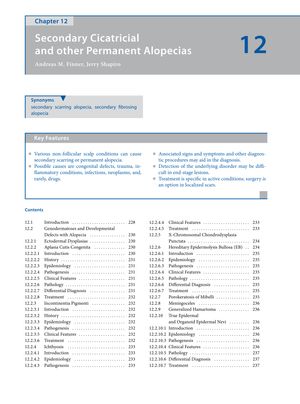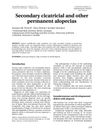Secondary Cicatricial and Other Permanent Alopecias
June 2008
in “
Springer eBooks
”
secondary cicatricial alopecia permanent alopecias scarring alopecia hair follicles congenital defects trauma inflammatory conditions infections neoplasms drugs secondary permanent alopecias atrophizing alopecias end-stage lesions surgery Incontinentia Pigmenti Ichthyosis X-Chromosomal Chondrodysplasia Punctata Hereditary Epidermolysis Bullosa Porokeratosis of Mibelli Meningoceles Generalized Hamartoma nevus sebaceous systemic medications topical medications

TLDR The document concludes that permanent hair loss conditions are complex, require early specific treatments, and "secondary permanent alopecias" might be a more accurate term than "secondary cicatricial alopecia."
The document from 2008 provides a comprehensive overview of secondary cicatricial (scarring) and other permanent alopecias, which are hair loss conditions resulting from the destruction of hair follicles due to various causes. It discusses congenital defects, trauma, inflammatory conditions, infections, neoplasms, and drugs as potential causes. The document suggests that terms like "secondary permanent alopecias" or "atrophizing alopecias" may be more accurate than "secondary cicatricial alopecia" since not all conditions cause true scarring. It highlights the difficulty in diagnosing these conditions, especially in end-stage lesions, and notes that treatment is specific to the active conditions with surgery as an option for localized scars. The document also details various specific conditions that can lead to permanent hair loss, such as Incontinentia Pigmenti, Ichthyosis, X-Chromosomal Chondrodysplasia Punctata, Hereditary Epidermolysis Bullosa, Porokeratosis of Mibelli, Meningoceles, Generalized Hamartoma, and nevus sebaceous. It emphasizes the rarity and complexity of these alopecias and the importance of early and appropriate treatment to prevent progression, including the use of systemic and topical medications, as well as surgical options in some cases.













